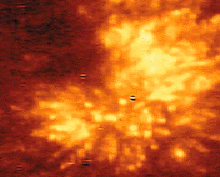![]()

INERTIAL CONFINEMENT FUSION has four stages. (a) Intense laser or ion beam illumination rapidly heats the surface of the fuel capsule. (b) The fuel is compressed by the rocket-like inward push of the hot surface material. (c) The final stage of the implosion allows the core to reach 20 times the density of lead and ignite at a temperature of 100,000,000 degrees centigrade. (d) The thermonuclear burn spreads rapidly through the compressed fuel, producing a burst of useful energy.
research for some time to come, such research enjoys strong governmental
support because of its utility for weapons research. The conditions within
a compressed fusion pellet are similar to those in a nuclear bomb. Therefore
these studies can be used to ensure the safety and efficacy of nuclear weapons
without actually detonating them.


LASER INDUCED plasma dynamics are often similar to important
astrophysical phenomena. (a) Emission from molecular hydrogen shocked by
winds from young stars in the Orion star-forming region. [Courtesy of Mark
McCaughrean and Mordecai-Mark Mac Low, Max Planck Institute for Astronomy];
(b) Blast wave produced in a laser-plasma experiment [Courtesy of Jacob
Grun, Naval Research Laboratory]. These two phenomena exhibit bullet-like
structures that are caused by hydrodynamic instabilities.
![]()
Even in such applied research, the surprising generality of plasma physics has recently begunto blossom, like a wild flower that grows whether you cultivate it or not. Researchers noticed that the shock waves created in the fuel pellets bear a strong resemblance to those that blast through a star when it explodes as a supernova. In stars, the turbulent stirring of gases produced by the shock waves enhances the supernova's explosive power, but the three-dimensional processes involved are too complicated to study in detail even on large computers. Preliminary experiments have shown, however, that the mixing can be studied in laser-generated plasmas-even though they are only fractions of a millimeter in size compared to supernova ten thousand kilometers across, and the mixing takes place in nanoseconds rather than weeks. Future experiments may recreate aspects of the well-observed supernova 1987a in a pellet that is smaller than a grain of sand.
For decades, laboratory plasmas have been demonstrating an uncanny ability to illuminate such dramatic and intellectually challenging displays, and the pace of discovery shows no sign of letting up. On the practical side of things, we already have a large economic stake in applications like lighting and plasma processing, and plasmas' overall societal impact seems destined for brisk growth into the next century as engineers work the kinks out of the newer applications while physicists come up with still more of them to try out. And if fusion fulfills its tantalizing promise, we could one day be sending our utility payments to the local tokamak.
Although clearly fortunate to be living on this congenial haven of ordinary
matter, humanity can't help but look out into the great picture window of
space and realize that the universe would be a vastly less interesting spectacle
without the plasmas that whirl and spark and storm their way through it,
lighting it up like some cosmic expansion of Las Vegas with every bulb burning.
Yet because we still have so much to learn about plasmas, the fireworks
generated by understanding them will be even more brilliant, as we struggle
with the subtleties of this astonishingly complex state of matter.
![]()